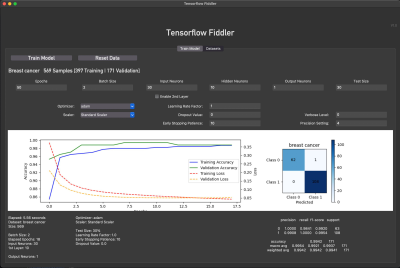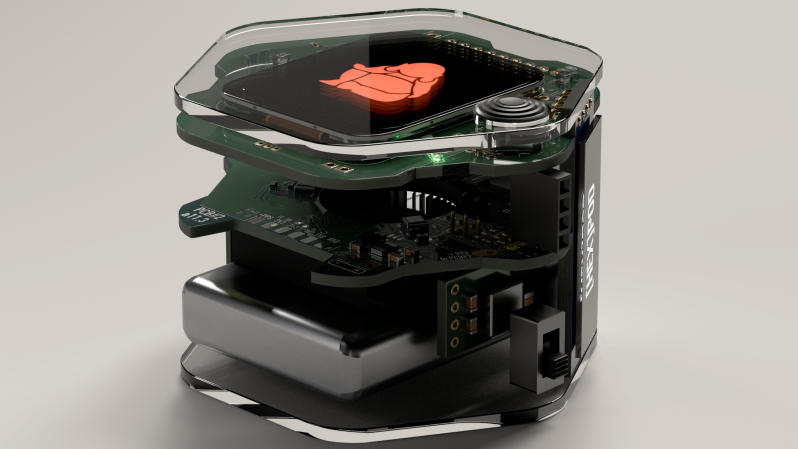[eBender] was travelling India with friends, when one got sick. Unable to find a thermometer anywhere during COVID, they finally ended up in a hospital. After being evacuated back home, [eBender] hatched an idea to create a portable gadget featuring a few travel essentials: the ability to measure body temperature and heart rate, a power bank and an illumination source. The scope evolved quite a lot, with the concept being to create a learning platform for environmental multi-sensor fusion. The current cut-down development kit hosts just the air quality measurement components, but expansion from this base shouldn’t be too hard.

This project’s execution is excellent, with a hexagon-shaped enclosure and PCBs stacked within. As everyone knows, hexagons are the bestagons. The platform currently hosts SCD41 and SGP41 sensors for air quality, a BME688 for gas detection, LTR-308 for ambient light and motion, and many temperature sensors.
On top sits a 1.69-inch IPS LCD, with an OLED display on the side for always-on visualization. The user interface is completed with a joystick and a couple of buttons. An internal blower fan is ducted around the sensor array to pull not-so-fresh air from outside for evaluation. Control is courtesy of an ESP32 module, with the gory details buried deep in the extensive project logs, which show sensors and other parts being swapped in and out.
On the software side, some preliminary work is being done on training TensorFlow to learn the sensor fusion inputs. This is no simple task. Finally, we would have a complete package if [eBender] could source a hexagonal LCD to showcase that hexagon-orientated GUI. However, we doubt such a thing exists, which is a shame.
There are many air quality sensors on the market now, so we see a few hacks based on them, like this simple AQ sensor hub. Let’s not forget the importance of environmental CO2 detection; here’s something to get you started.


















The words “OLED” and “always-on” really don’t belong in the same sentence, unless the word “never” is also present. OLEDs, like their electroluminescent ancestors, have a limited lifetime, and it’s in hundreds of hours, not tens of thousands. I’ve seen comments on Amazon, about devices that were always on, and had OLED displays, and the complaint was that after two or three months, the display was unreadable. Better to use a monochrome LCD without a backlight, which uses even less power, and lasts much longer.
Indeed. Seems an odd choice. I’ve experienced very limited lifetime with several OLED displays over the years. In fact I walked into a reptile shop in the South of England years ago that had new enclosure controllers for all the stacks on display, and noticed they had OLED displays and neartly every one of them was either showing dead pixels or almost unreadable images.
You literally need any source of time whatsoever and the ability to count to measure heart rate. Also “was travelling India with friends, when one got sick. Unable to find a thermometer anywhere during COVID..” is both poorly copy edited (traveling IN/TO/AROUND India..) and … like, isn’t that the exact opposite of what a lockdown or whatever was supposed to accomplish?
Interesting comment about the need for “IN/TO/AROUND…” This seem to be a case of condemning “style” rather than standards. IMO, the sentence does all the work it is supposed to exactly as it it stands, without the added verbosity. Much writing suffers from too much wordiness, and removing the excess is a time-consuming task. I highly suggest books on writing by Rudolf Flesch, William Zinser, and S. I. Hayakawa. Your life will then be consumed by endless and frustrating) attempts to hunt and destroy wordiness.
(Sigh) Of course, I made a typo: “(and frustrating)”. Sorry. I would blame it on old age and bad eyesight, but I’m only 76…
Dropping a word here and happens. I’m not young by any standard.
.
It’s more the dude from article traveling during lockdown, getting sick, and basically doing exact opposite of avoiding spreading a pandemic that I think is ridic. Plus coming up with a heart rate sensor which is just…
Couldn’t find a thermometer, so built an air-quality indicator instead?
If you’re worried about air quality, don’t go to India.
Although the design of this hexpod is nice, the concept is failed. A digital thermometer that you stick in your armpit costs $5. I don’t understand how getting sick in India is related to air quality monitoring. What?
Get Bluebeam Revu 20 Perpetual License Key, One time payment for a lifetime, No need to pay any monthly fees or subscription
https://essentialskeys.com/product/bluebeam-revu/